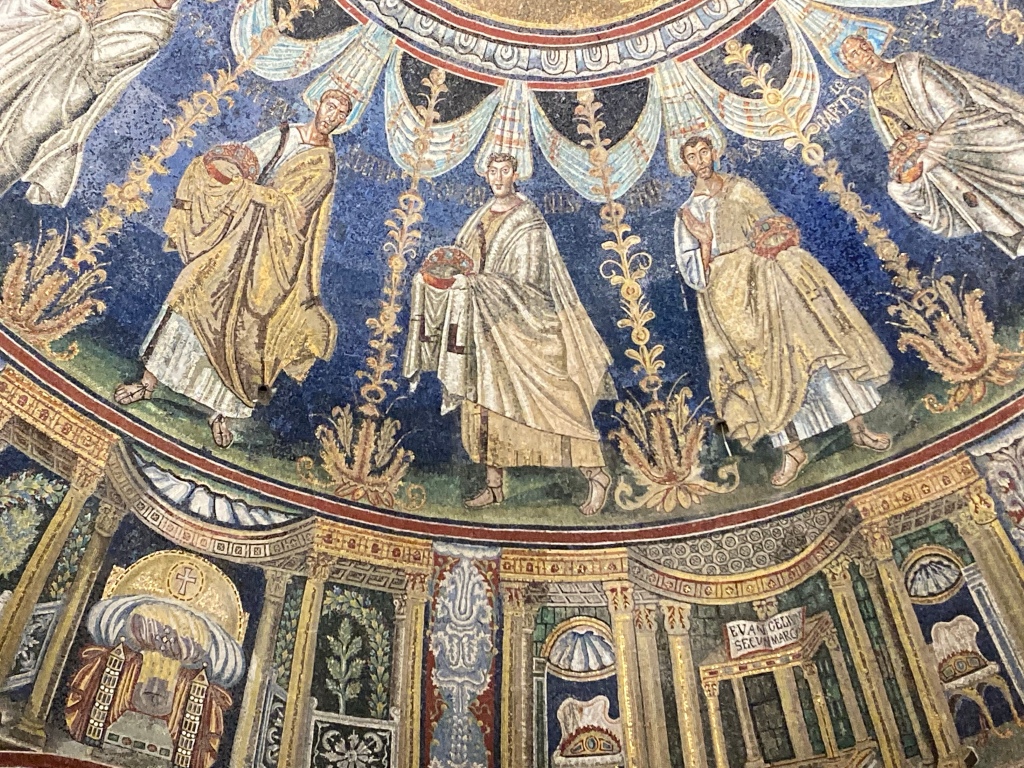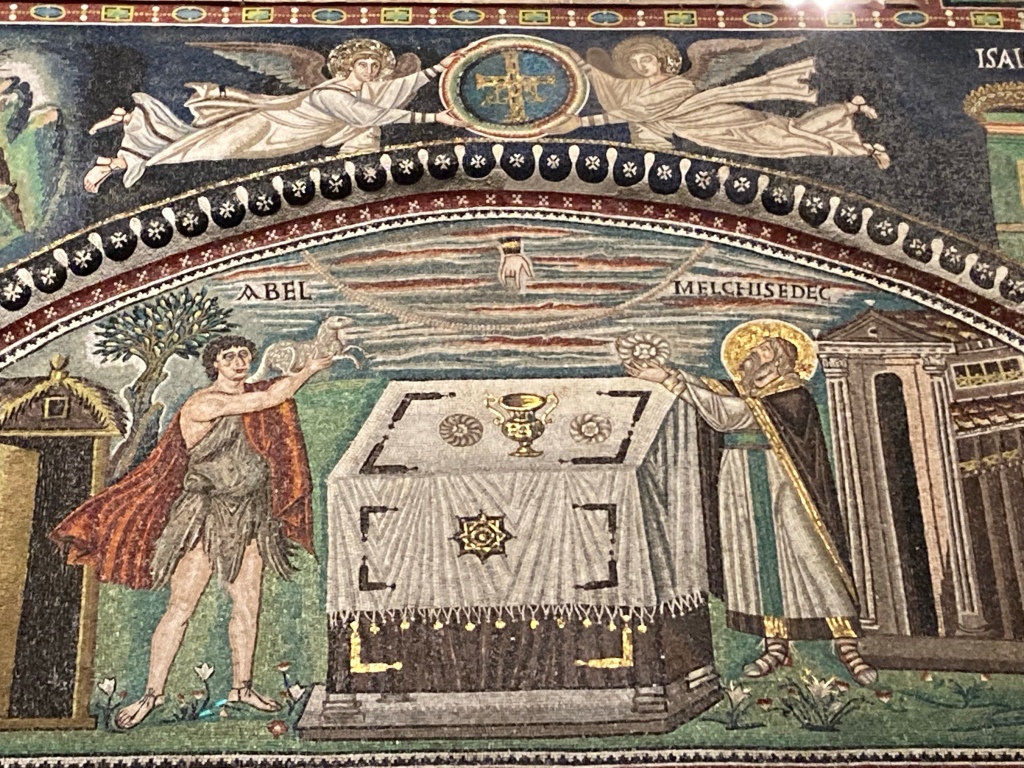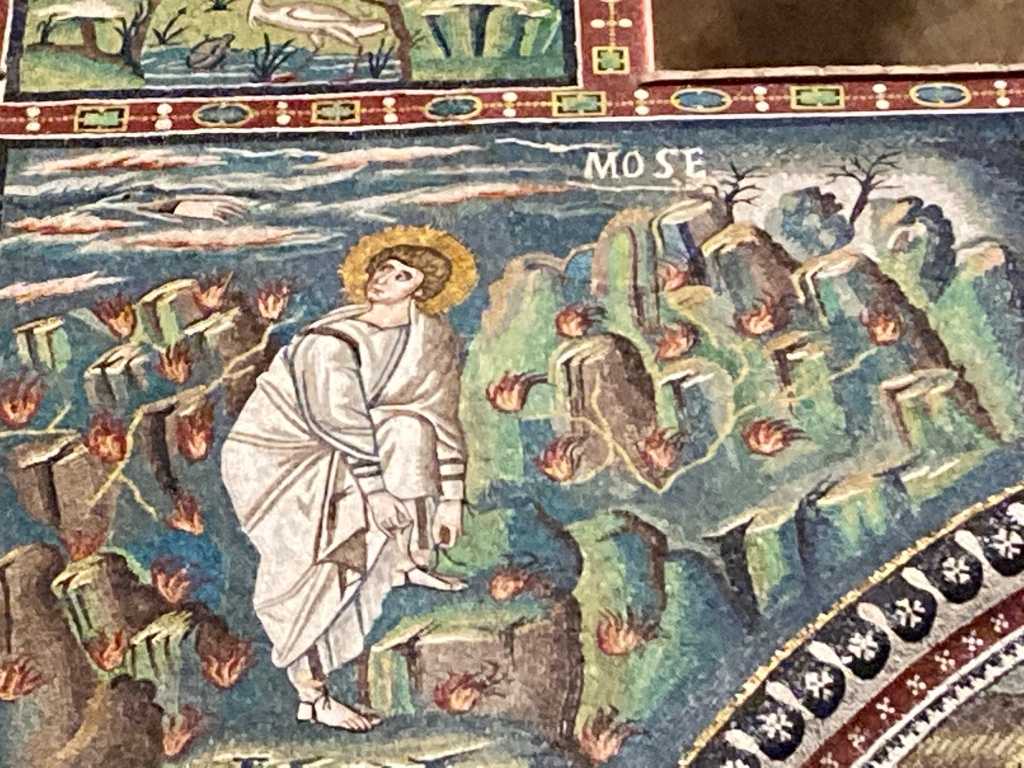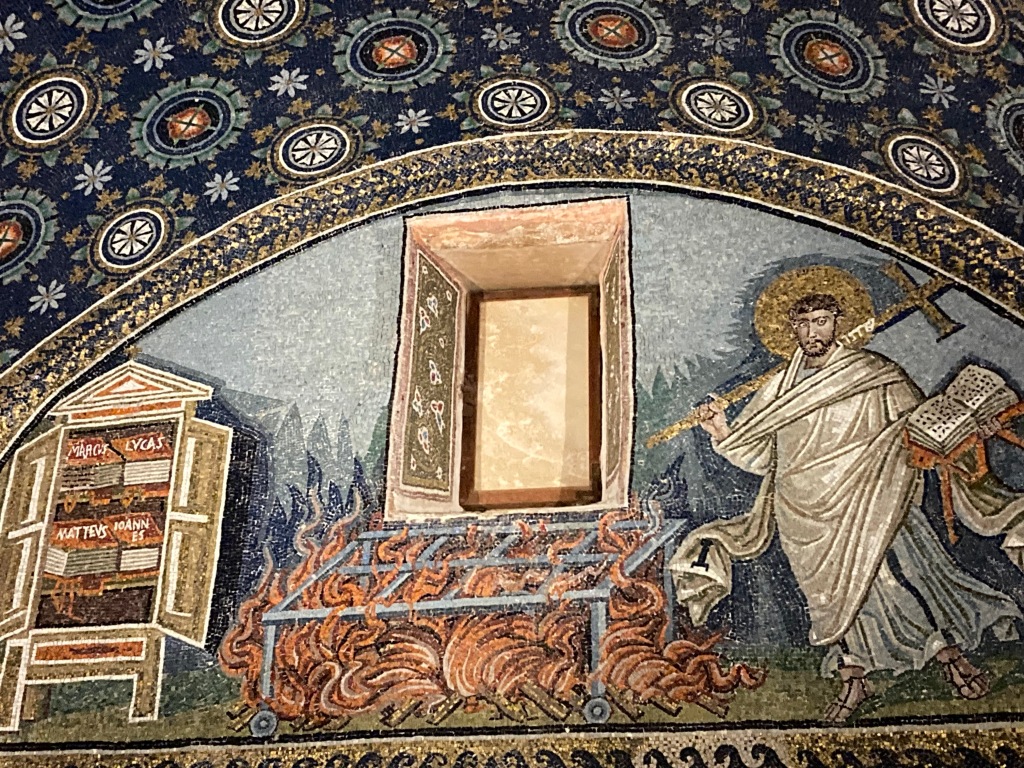




Byzantine mosaics at Battistero Neoniano show John the Baptist baptizing Christ in River Jordan (5th-6th century)
The spectacular mosaics of Ravenna dazzle and shimmer. The colours are rich and joyful. Scenes from the Bible and the life of Christ are displayed in great detail. Every mosaic picture is created with thousands of small ‘tesserae’ pieces. Each ‘tessera’ is a small square about the size of a thumbnail (1 cm square). They are made of clear glass and coloured glass: gold, green, blue, red, every shade and hue imaginable. There used to be a ‘tessera’ workshop in Aquileia (near Venice) in Roman times. These ‘tesserae’ pieces would have been shipped from the Northern Adriatic Sea southwards to Classe (the port of Ravenna) and further south to Ancona, Bari and Sicily. Quite incredibly these mosaics date from the 6th century – around 570 AD. So the mosaics we can appreciate and admire in Ravenna today are more than 1400 years old.
The style of these mosaics is known as Byzantine. They are known for their vibrant colours and exceptional depictions of Biblical scenes. The city of Ravenna has the finest collection and range of these Byzantine mosaics in the entire Italian peninsula. The craftsmen who created these fantastical scenes were brought to Italy from Byzantium (later Constantinople) at the time when Justinian was the Emperor of a weakened and divided Roman Empire. When the mosaics in Ravenna were created the Western Roman Empire was ruled from the small Adriatic city, whilst Justinian ruled the Eastern Roman Empire from Byzantium.
Justinian was keen to exert influence on the Western Empire even though he was based in the East. The Roman Empire was in its twilight years and had already split into two in an effort to survive. However invaders had continued to seriously undermine Rome’s authority and by the time of the Sack of Rome by the Visigoths in the early years of the 5th century, Ravenna had already become the capital city of the Western Roman Empire.
Goths, Visigoths, Lombards and the infamous Hun led by Attila were all keen to seize bits of the Roman Empire. Ravenna with its important Roman port at Classe, located on the Adriatic Sea was a vital and strategic link between Byzantium (in the east) and Rome (in the west). Interestingly Christianity was experiencing a greater danger from invaders in the west than it was in the east at the time (4th to 6th centuries). So the mosaics of Ravenna could have been a political tool used by the emperors of the time to consolidate the Christian message and demonstrate their power, at a time when actually – in reality – they were very exposed and at risk of invasion and even defeat from a variety of Pagan and non-Christian groups.





If we focus for a minute on the mosaics themselves, the stories they tell and the characters they depict are completely enthralling and engaging. In the mosaic above we have the Three Kings (Magi) from the Bible hurrying to Bethlehem to honour the newly born king. We can see that they are bearing the well-known gifts of gold, frankincense and myrrh. Each king is dressed differently, they each wear richly decorated capes and carry elaborately carved, metallic bowls. The level of detail in the mosaic is exceptional they are following the star that guided them to Jesus’ birthplace, top right in the sky. Facially the individual characters show expression and determination. The viewer can imagine what Balthassar, Melchior and Gasper might say when they arrive at the stable door to deliver their gifts. I’m using the spelling of the names that we see depicted in the mosaic above. These mosaics decorate the north wall of the Basilica of Sant’Apollinare Nuovo.
A short walk from the Basilica of Sant’Apollinare Nuovo is the fascinating Basilica of San Vitale, a late antique church of the 6th century. The Basilica has an octagonal form combining Roman and Byzantine architectural styles. It contains the most extensive and best preserved Byzantine mosaics outside Istanbul. When I looked around the outside of the building I was convinced, just for a few moments that I’d accidentally ventured into Ancient Byzantium and that I was admiring the monumental church of Hagia Sophia (Santa Sofia) which is remarkably similar in style and dates from 360 AD. But no, I was in Ravenna not Byzantium and as night fell and I entered the church, the brilliance of the mosaics within stopped me dead in my tracks.


San Vitale, Ravenna in the twilight and then San Vitale (right) as night falls, Ravenna – http://www.greyhoundtrainers.com
The mosaics that cover the walls of San Vitale are breathtaking in their size and colour and scope. Everywhere I looked there was a tale being told. Abraham sacrificing his son Isaac, Moses surrounded by a veritable horde of burning bushes, the Hand of God appearing from the clouds to guide us mere mortals in the ways of the Christian world. All of it laid out in the most intricate detail, with pastoral landscapes, celestial blue skies and daring use of colour. Rich fabrics and drapes, flags and banners, curtains and tablecloths (complete with tassels) all faithfully reproduced using thousands and thousands of tiny glass tesserae.





From the Basilica of San Vitale it’s just a two minute walk across the garden to the Mausoleo of Galla Placidia. This ancient building was constructed as the final resting place of Galla Placidia. Galla Placidia was the daughter of the Roman emperor Theodosius I. She was mother, tutor and advisor to emperor Valentinian III, and she was a major force in Roman politics for most of her life. She lived from around 388 – 450 AD. In fact she died in Rome and was buried there, so the gargantuan marble tomb inside the mausoleum remains empty. However the interior decoration of the burial place is just amazing. The mosaics take the viewer on a celestial journey to a sky populated with stars and flowers, exquisite shades of blue and a richness and vibrancy that challenges our imagination. Cole Porter is said to have been inspired to write ‘Night and Day’ after visiting this place.
Two mosaics stand out particularly for me in the mausoleum. They are two lunettes (semi-circular) mosaics, one above the main door and the other facing the spectator as you enter. I’ll start with The Good Shepherd (on the left hand side – below). The Good Shepherd mosaic dates from about 425 AD, it is one of the oldest in Ravenna and depicts a youthful Christ watching over his sheep. The sheep represent goodness and serenity, perhaps faithful members of the Christian community. Whilst a pale-skinned Jesus dutifully supervises his charges. This mosaic has been copied on numerous occasions, there is an excellent copy in the Victoria & Albert Museum in London. It is massively significant because it is one of the earliest images of a caring Christ protecting his followers from the evils of the wild and savage world. Food for thought indeed. These mosaics have exerted quite an influence when you remember that ‘The Good Shepherd’ is now almost 1700 years old.


My absolute favourite mosaic in the mausoleo is the lunette on the opposite wall to the entrance. It shows San Lorenzo (an early Christian martyr) stood next to a huge burning fire. On the left hand side of the mosaic is a cabinet, holding copies of the four gospels. I wonder if this is the earliest depiction of a library. Whilst it was the manuscripts that caught my attention to start with, I soon began to wonder about the holy man on the right, with his worrying proximity to open flames and in fact I was right to be worried about that.
This is San Lorenzo’s sorry story. San Lorenzo was an early Christian martyr who was made a Deacon of the church in Rome. He was in charge of giving alms (financial assistance) to the poorer members of the community. He was also put in charge of the church’s treasures. Rather amusingly he distributed these treasures amongst the poor. He declared that their need was greatest. When the Prefect of Rome discovered San Lorenzo’s exceptional generosity, he sacked him immediately and ordered him to be put to death. A giant gridiron with hot coals beneath and flames licking through the metal bars was prepared and Lorenzo was laid on top – like a large lamb about to be roasted. Legend has it that after a significant period of time he declared himself to be cooked on one side and requested to be turned over. From this supposed witticism, San Lorenzo became the patron saint of chefs, cooks and comedians. Rather tragically and predictably he did not survive the grilling!

I was so impressed and overwhelmed by the Ravenna mosaics that it’s taken me several weeks to organise my thoughts and to write, what I hope is, a coherent and engaging summary of these amazing historic treasures. I’ll be heading back to Ravenna in 2023 and in fact I’m intending to put together a small group, possibly in late April next year to stay in Ravenna for a couple of days and to take the time to absorb these exceptional art works at different times of the day. For now I’ll leave you with a selection of links and articles that will offer further insight into the rich cultural heritage of Byzantine mosaics in Italy from the 5th century onwards. No wonder UNESCO declared the mosaic sites of Ravenna to be of ‘World Heritage’ status in 1996.

Empress Theodora, Basilica of San Vitale, Ravenna – 6th century mosaics
Notes:
- A little more on the Battistero Neoniano, Ravenna – an incredible octagonal-shaped baptistery building. A combination of Christian and Byzantine art. Built by Bishop Neonis (450-475). One of the best preserved baptismal buildings in the world, both for the architectural structure and for the interior mosaics, dating from the late 5th century (c.470 CE). Similar ancient baptisteries were built in Antioch, Constantinople, Ephesus, Trier, Milan, Aquileia and Rome around the same time. However, elsewhere only the perimeter walls or basements (foundations) survive.
- To discover more: Neonian Baptistery, Ravenna
- Sant’Apollinare in Classe – yet another of the Ravenna mosaic sites: Sant’ Apollinare in Classe
- Travelling from Venice to Ravenna: Venice to Ravenna on the old Roman road
- Exceptional mosaics on the island of Torcello, Venice: Torcello – Island of legends – Hemingway, Cipriani, Venice
- Meanwhile in Sicily there are exceptional mosaics (11th century) in Cefalu and Palermo and Monreale
- Whilst in Rome my favourites would be the 6th century (heavily restored) mosaics of Santi Cosma & Damiano
- Santi Cosma and Damiano (detail below) – for next time you are walking past The Forum!

Early 6th century mosaics in the church of Santo Cosma and Damiano, Roma

Poor Lorenzo – things were not going to go well for him!
November 2022


Why not add charming small hotels, bed and breakfast as well as good restaurants?
LikeLiked by 1 person
I actually run tours in Italy for small groups and individuals, so I tend to keep the best accommodation and nicest restaurants up my sleeve for paying guests. There are some wonderful family-run osterias in Ravenna.
LikeLiked by 1 person